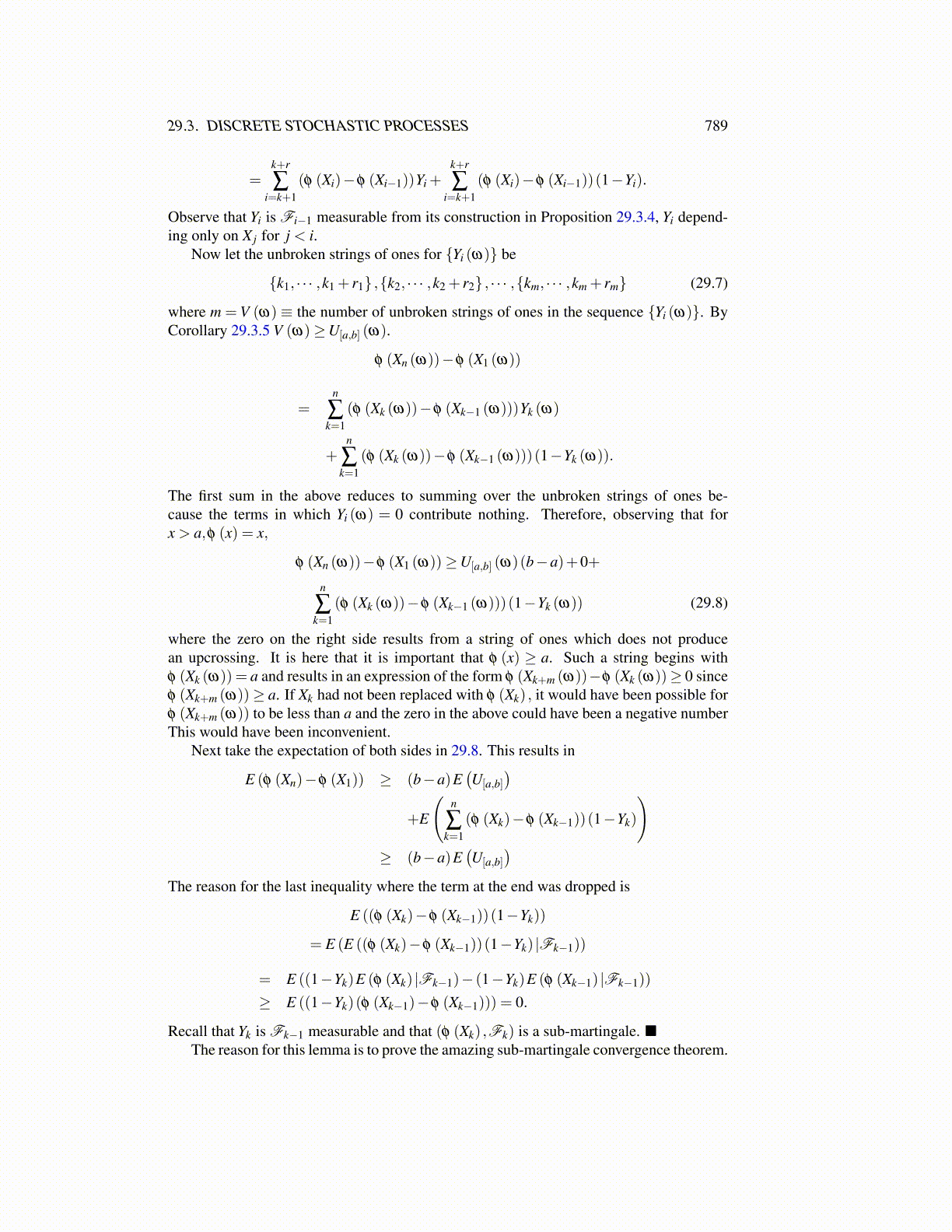
29.3. DISCRETE STOCHASTIC PROCESSES 789
=k+r
∑i=k+1
(φ (Xi)−φ (Xi−1))Yi +k+r
∑i=k+1
(φ (Xi)−φ (Xi−1))(1−Yi).
Observe that Yi is Fi−1 measurable from its construction in Proposition 29.3.4, Yi depend-ing only on X j for j < i.
Now let the unbroken strings of ones for {Yi (ω)} be
{k1, · · · ,k1 + r1} ,{k2, · · · ,k2 + r2} , · · · ,{km, · · · ,km + rm} (29.7)
where m = V (ω) ≡ the number of unbroken strings of ones in the sequence {Yi (ω)}. ByCorollary 29.3.5 V (ω)≥U[a,b] (ω).
φ (Xn (ω))−φ (X1 (ω))
=n
∑k=1
(φ (Xk (ω))−φ (Xk−1 (ω)))Yk (ω)
+n
∑k=1
(φ (Xk (ω))−φ (Xk−1 (ω)))(1−Yk (ω)).
The first sum in the above reduces to summing over the unbroken strings of ones be-cause the terms in which Yi (ω) = 0 contribute nothing. Therefore, observing that forx > a,φ (x) = x,
φ (Xn (ω))−φ (X1 (ω))≥U[a,b] (ω)(b−a)+0+
n
∑k=1
(φ (Xk (ω))−φ (Xk−1 (ω)))(1−Yk (ω)) (29.8)
where the zero on the right side results from a string of ones which does not producean upcrossing. It is here that it is important that φ (x) ≥ a. Such a string begins withφ (Xk (ω)) = a and results in an expression of the form φ (Xk+m (ω))−φ (Xk (ω))≥ 0 sinceφ (Xk+m (ω))≥ a. If Xk had not been replaced with φ (Xk) , it would have been possible forφ (Xk+m (ω)) to be less than a and the zero in the above could have been a negative numberThis would have been inconvenient.
Next take the expectation of both sides in 29.8. This results in
E (φ (Xn)−φ (X1)) ≥ (b−a)E(U[a,b]
)+E
(n
∑k=1
(φ (Xk)−φ (Xk−1))(1−Yk)
)≥ (b−a)E
(U[a,b]
)The reason for the last inequality where the term at the end was dropped is
E ((φ (Xk)−φ (Xk−1))(1−Yk))
= E (E ((φ (Xk)−φ (Xk−1))(1−Yk) |Fk−1))
= E ((1−Yk)E (φ (Xk) |Fk−1)− (1−Yk)E (φ (Xk−1) |Fk−1))
≥ E ((1−Yk)(φ (Xk−1)−φ (Xk−1))) = 0.
Recall that Yk is Fk−1 measurable and that (φ (Xk) ,Fk) is a sub-martingale. ■The reason for this lemma is to prove the amazing sub-martingale convergence theorem.